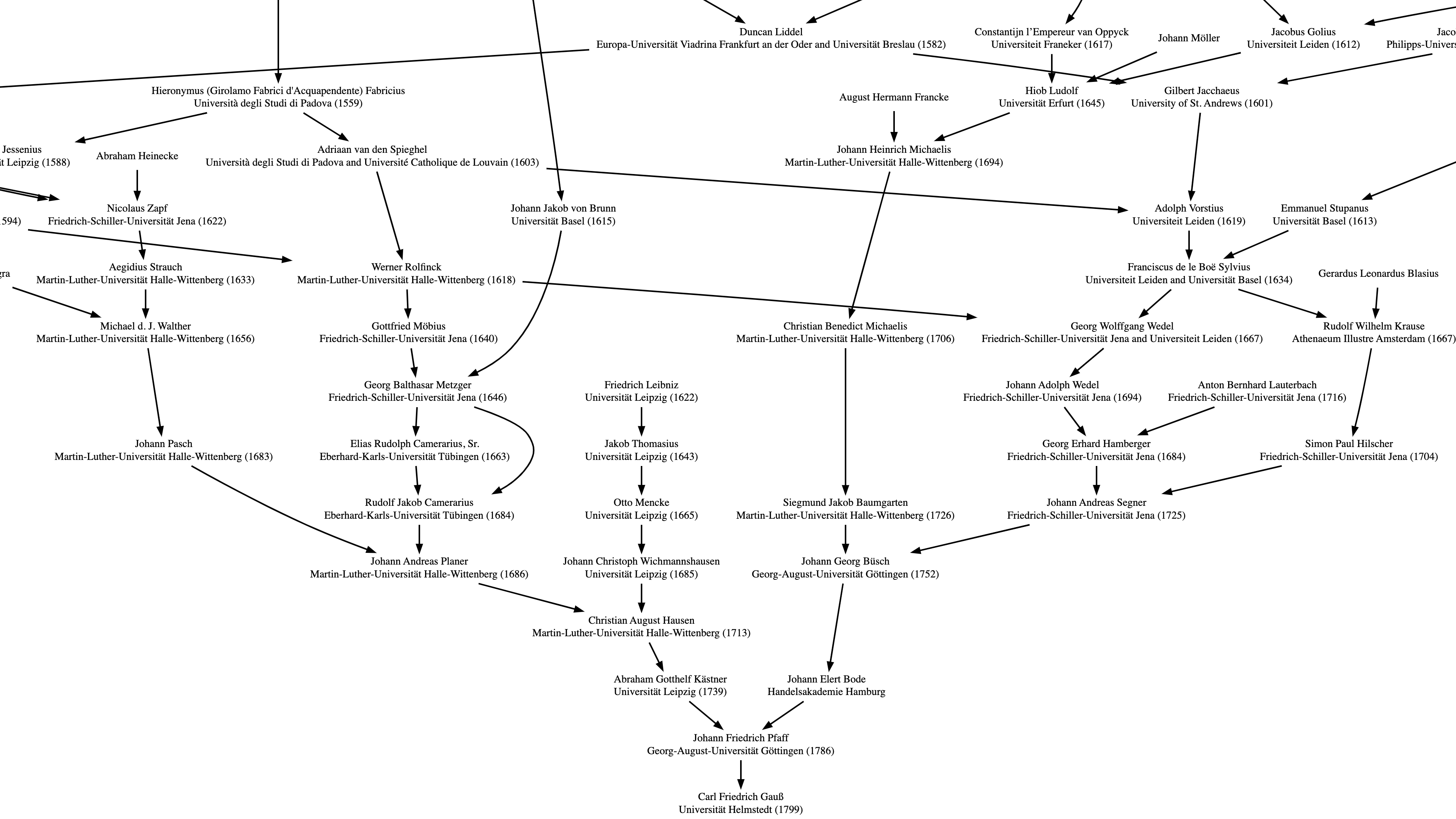I recently completed one of Geneagrapher’s once-or-twice-per-decade updates. This update makes Geneagrapher easier than ever to use! It also delivers significant amounts of rebuilt code and overall modernization. If you are a math or math history enthusiast or have a doctoral degree and mathematician “ancestors”, you might want to check it out.
What is Geneagrapher?
Geneagrapher is a tool that quickly constructs mathematician academic genealogies using data from the Math Genealogy Project (thank you!). Once the genealogy data is assembled, it can be visualized as a graph, such as the image below. I have maintained Geneagrapher since 2006, when I was in graduate school.

What’s New?
- The Geneagrapher Observable notebook. This works in your web browser and is the easiest way to build a math genealogy.
- Updates to the Geneagrapher Python package:
- Increased flexibility in controlling the graph traversal directions. Previously, traversal from the graph’s starting nodes was either all in the advisor direction or in the descendant direction. Traversal directions are now specified on a per-node basis. This has led to some syntax changes in the tool’s usage, so commands that worked in Geneagrapher 1.0.0 will not work in 2.0.0.
- The previous versions of Geneagrapher were targeted at Python 2. Geneagrapher 2.0.0 is the first version that is targeted at Python 3.
More changes are detailed in the release notes.
How to Use Geneagrapher
You have two options:
- Use the Observable notebook in your web browser.
- Install the Python package. Everything you need to know about using the Geneagrapher Python package is here.
How Geneagrapher Got Here
It has been a long time since there was a major Geneagrapher update. I believed this project was de facto done or dead, but over the years a few users have filed issues or made contributions. Then, the Python Software Foundation finally removed support for Python 2 and the world switched to Python 3. That created problems for Geneagrapher’s users since it didn’t work in Python 3 without some modification. Users also began having problems with some of the old dependencies. I decided to work on an update to eliminate the old-code problems that users were experiencing, but I wanted to do more than the minimal fix in this case.
Geneagrapher was originally a web service hosted on my graduate school workstation. I eventually graduated, and that ultimately led to the shutdown of that service. That impending shutdown is what led to the creation of the Python package that has been available since 2008. Since that time I have wanted to provide a service that could make it easy for a larger audience to use Geneagrapher. For a variety of reasons (including the difficulty of hosting a service, initially), that didn’t happen until now.
I wanted to make Geneagrapher available to a larger audience. This was approached by publishing an Observable notebook, which empowers users who were not interested in installing a Python package. In order to support the notebook and the Python package with a shared code base, I reorganized the code and have also deployed a service that is used to retrieve records during the graph-building process.
In fact, it’s not absolutely necessary to have a Geneagrapher service to make it easy for users to build graphs. I could have reimplemented the Geneagrapher data extraction in JavaScript and built an Observable notebook that retrieves data, in addition to rendering graphs. Still, I built a service, primarily for two reasons:
- I wanted to learn how much Geneagrapher is used.
- I wanted to centralize caching of mathematician records retrieved from the Math Genealogy Project. The benefits of this are that it’s much faster for users to build graphs, and it reduces request volume to the Math Genealogy Project by a lot.
Feedback
If you find Geneagrapher useful and want to say so, please star the repository or send me an email or message on LinkedIn. It’s always motivating to hear that people have enjoyed using Geneagrapher.
If you have other feedback or requests, consider contacting me or opening an issue.